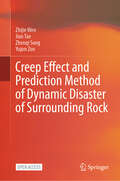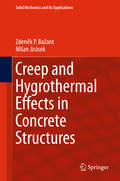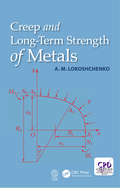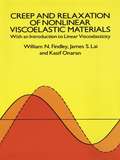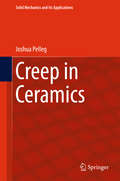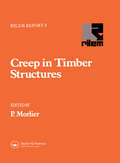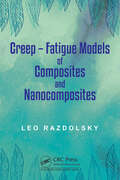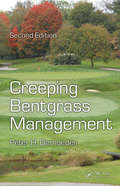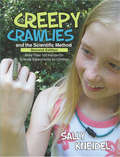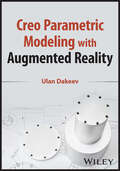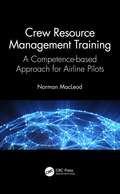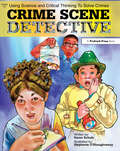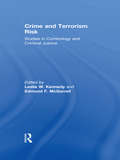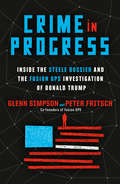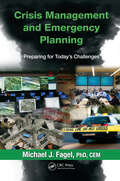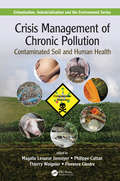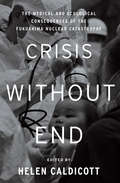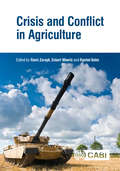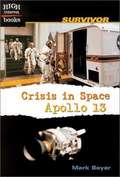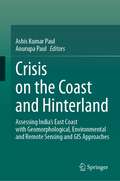- Table View
- List View
Creep Effect and Prediction Method of Dynamic Disaster of Surrounding Rock
by Jian Tao Zhijie Wen Zhenqi Song Yujun ZuoThis open access book provides a comprehensive overview of the author&’s in-depth insights into the theory, prediction methods, and developmental trends of creep instability and failure in coal-rock masses within mining stopes. The content primarily covers topics such as creep instability of coal-rock masses in stopes, creep instability of surrounding rock in roadways, large-scale roof creep instability, creep instability of overlying strata in goaf, rockburst, gas outburst, and principles and prediction of roof creep instability in fully mechanized mining faces. Additionally, it explores theoretical advancements in analyzing the energy principles of coal-rock masses and acoustic wave monitoring of coal-rock systems. This book serves as a valuable reference for professionals and researchers in mining engineering, mine construction, underground space engineering, and geotechnical engineering, as well as for faculty and students in related fields.
Creep and Fracture of Engineering Materials and Structures: Proceedings of the 9th International Conference
by J D ParkerThis volume contains the 75 papers from the Proceedings of the 9th International Conference on Creep and Fracture of Engineering Materials and Structures, held at University of Wales Swansea, 1st April- 4th April 2001.
Creep and Hygrothermal Effects in Concrete Structures (Solid Mechanics and Its Applications #225)
by Zdeněk P. Bažant Milan JirásekThis comprehensive treatise covers in detail practical methods of analysis as well as advanced mathematical models for structures highly sensitive to creep and shrinkage. Effective computational algorithms for century-long creep effects in structures, moisture diffusion and high temperature effects are presented. The main design codes and recommendations (including RILEM B3 and B4) are critically compared. Statistical uncertainty of century-long predictions is analyzed and its reduction by extrapolation is discussed, with emphasis on updating based on short-time tests and on long-term measurements on existing structures. Testing methods and the statistics of large randomly collected databases are critically appraised and improvements of predictions of multi-decade relaxation of prestressing steel, cyclic creep in bridges, cracking damage, etc. , are demonstrated. Important research directions, such as nanomechanical and probabilistic modeling, are identified, and the need for s eparating the long-lasting autogenous shrinkage of modern concretes from the creep and drying shrinkage data and introducing it into practical prediction models is emphasized. All the results are derived mathematically and justified as much as possible by extensive test data. The theoretical background in linear viscoelasticity with aging is covered in detail. The didactic style makes the book suitable as a textbook. Everything is properly explained, step by step, with a wealth of application examples as well as simple illustrations of the basic phenomena which could alternate as homeworks or exams. The book is of interest to practicing engineers, researchers, educators and graduate students.
Creep and Long-Term Strength of Metals
by A. M. LokoshchenkoCreep and Creep Rupture of Metals is devoted to the fundamental description of the phenomenon of creep which occurs widely in high-temperature deformation of metals. Special attention is paid to the analysis of long-term strength, which characterizes the stress at which the metal does not fail after a predetermined time. The author details experimental and theoretical results obtained by Soviet and Russian scientists that are absent in currently available publications and demonstrates analytical methods and approaches to achieve long term strength in Metals.
Creep and Relaxation of Nonlinear Viscoelastic Materials (Dover Civil and Mechanical Engineering)
by Francis A. Davis William N. FindleyThis pioneering book presents the basic theory, experimental methods, experimental results and solution of boundary value problems in a readable, useful way to designers as well as research workers and students. The mathematical background required has been kept to a minimum and supplemented by explanations where it has been necessary to introduce specialized mathematics. Also, appendices have been included to provide sufficient background in Laplace transforms and in step functions. Chapters 1 and 2 contain an introduction and historic review of creep. As an aid to the reader a background on stress, strain, and stress analysis is provided in Chapters 3 and 4, an introduction to linear viscoelasticity is found in Chapter 5 and linear viscoelastic stress analysis in Chapter 6. In the next six chapters the multiple integral representation of nonlinear creep and relaxation, and simplifications to single integral forms and incompressibility, are examined at length. After a consideration of other representations, general relations are derived, then expanded to components of stress or strain for special cases. Both constant stress (or strain) and variable states are described, together with methods of determining material constants. Conversion from creep to relaxation, effects of temperature and stress analysis problems in nonlinear materials are also treated here. Finally, Chapter 13 discusses experimental methods for creep and stress relaxation under combined stress. This chapter considers especially those experimental problems which must be solved properly when reliable experimental results of high precision are required. Six appendices present the necessary mathematical background, conversion tables, and more rigorous derivations than employed in the text. An extensive updated bibliography completes the book.
Creep in Ceramics (Solid Mechanics and Its Applications #241)
by Joshua PellegThis textbook is one of its kind, since there are no other books on Creep in Ceramics. The book consist of two parts. In part A general knowledge of creep in ceramics is considered, while part B specifies creep in technologically important ceramics, namely creep in oxide ceramics, carnides and nitrides. While covering all relevant information regarding raw materials and characterization of creep in ceramics, the book also summarizes most recent innovations and developments in this field as a result of extensive literature search.
Creep in Timber Structures
by P. MorlierThis book brings together up to date information from research and practice about the interaction between moisture changes and mechanical loading, which may lead to excessive deflections or joint movements in timber structures. It has important applications in timber engineering, and consequences for national and international structural codes of practice.
Creep-Fatigue Fracture: Analysis of Internal Damage (Springer Series in Materials Science #344)
by Junji Sakamoto Weisheng Zhou Naoya TadaThis book presents a detailed analysis of the processes of internal damage and healing of damage in high-temperature creep-fatigue. This analysis is based on experimental results and a three-dimensional visualization and simulation method. It focuses on inner cracking type fracture, which is essential to consider for creep-fatigue in actual equipment and structures used at high temperatures for long periods of time. In this book, systematic studies of the fracture are presented by introducing three-dimensional simulation and visualization methods. This book is for designers and researchers in industry specializing in strength of materials at high temperatures. It is also for a postgraduate or higher academic audience specializing in mechanical engineering and materials science engineering. In reading the book it is expected that readers will acquire knowledge of evaluation techniques for high-temperature creep-fatigue damage. In addition, this book allows readers toimprove the accuracy of damage evaluation, design materials for longer lifetimes, and apply the described techniques to other materials.
Creep: Fatigue Models of Composites and Nanocomposites
by Leo RazdolskyIn recent years, the application of composites and nanocomposites has been increasing steadily in industries such as aerospace, automotive, marine, and civil engineering. It is among the most complex and crucial aspects of the mechanics of a deformable solid, due to several specific phenomena and analytic factors arising from cyclic loading. The problems are primarily associated with the development of fatigue damage, and the need to assess the cyclic and structural instability of composite and nanocomposite materials. The study of structural strength under cyclic loading has gained much attention, especially in aircraft manufacturing, power engineering, aviation, and rocket technology. Cyclic loading significantly reduces creep-fatigue lifespan during the entire frequency range. It is clear that characteristics such as endurance limit, static creep limits and long-term static strength will not suffice in the design criteria for fatigue life. New aspects have emerged in high-temperature strength - cyclical creep and long-term cyclic strength, leading to the creation of new methods and means of determining the resistance of composites and nanocomposites materials and continuum damage development under cyclic loading to the creation of appropriate physical models. Particularly relevant is the intensification of creep by high-frequency cyclic loading in composite materials, which usually occurs at high temperatures. Most studies in the field of cyclic creep are experimental, and the direct use of number of cycles to define damage model cannot escape the empirical relation that predicts multi-stress level fatigue life well. The book presents new phenomenological cyclic creep – fatigue models for describing the fatigue life and behavior of time-dependent composites and nanocomposites. Since the main difference between the creep process from the fatigue process is that from a physical point of view, the first is quasi-static, and the second is dynamic. Therefore, the functions of creep should reflect the oscillatory nature of the fatigue process. The results are supported by step-by-step practical design examples and will be useful for practicing structural engineers, code developers as well as research and university faculty.
Creeping Bentgrass Management
by Peter H. DernoedenCreeping bentgrass is considered the premier turfgrass species grown on golf courses, and there is a growing demand for an understanding of its maintenance and management practices. Still the only comprehensive reference on the subject, Creeping Bentgrass Management, Second Edition helps you identify the factors that contribute to summer bentgrass
Creepy Crawlies and the Scientific Method
by Sally KneidelFrom monarch butterflies to hissing cockroaches, Creepy Crawlies and the Scientific Method, Second Edition shows teachers and parents how to use bugs, insects and critters to teach children the five steps of the scientific method: question, hypothesis, methods, result, and conclusion. Focusing on fun as well as education, and operating on the premise that doing is learning, Creepy Crawlies offers more than 100 different activities which will ignite children's curiosity while also building foundations for critical thinking and scientific understanding. This classroom-tested collection of experiments is a perfect resource for teachers or just an afternoon of educational fun at home. The second edition includes updated content and four new insect species: the monarch butterfly, the black swallowtail butterfly, the bessbug, and the Madagascar hissing roach!Sally Kneidel, PhD, grew up next to a small creek and experienced crawling creatures at an early age. Her interest led her to ultimately pursue a PhD in biology from the University of North Carolina-Chapel Hill. Kneidel has now taught for more than fifteen years, including college biology courses and writing classes. She writes on a variety of science topics, ranging from health to wildlife conservation, has published numerous other books, and has won several awards for writing, blogging, and photography. The first edition of this book, and the sequel to it, were both named in Science Books & Films' "Best Books for Children" list.
Creo Parametric 9.0 Tutorial
by Roger ToogoodThe eleven lessons in this tutorial introduce you to the design capabilities of Creo Parametric 9.0. The tutorial covers the major concepts and frequently used commands to advance from a novice to an intermediate user level. Major topics include part and assembly creation and the creation of engineering drawings. Also illustrated are the major functions that make Creo Parametric a parametric solid modeler. Although the commands are presented in a click-by-click manner, an effort has been made, in addition to showing/illustrating the command usage, to explain why certain commands are being used and the relation of feature selection and construction to the overall part design philosophy. Simply knowing where commands can be found is only half the battle. As is pointed out numerous times in the text, creating useful and effective models of parts and assemblies requires advance planning and forethought. Moreover, since error recovery is an important skill, considerable time is spent exploring the created models. In fact, some errors are intentionally induced so that users will become comfortable with the "debugging" phase of model creation. At the end of each lesson is a short quiz reviewing the new topics covered in that chapter. Following the quiz are several simple "exercise" parts that can be created using new commands taught in that lesson. In addition to these, an ongoing project is also included throughout the book. This project consists of several parts that are introduced with the early lessons and finally assembled at the end. Who this book is for This book has been written specifically with students in mind. Typically, students enter their first CAD course with a broad range of abilities, both in spatial visualization and computer skills. The approach taken here is meant to allow accessibility to persons of all levels. These lessons, therefore, were written for new users with no previous experience with CAD, although some familiarity with computers is assumed.
Creo Parametric Modeling with Augmented Reality
by Ulan DakeevCreo Parametric Modeling with Augmented Reality Tutorial-based introduction to 3D Modeling with Creo Parametric, including images to be scanned and viewed using an AR mobile app Using a tutorial approach, Creo Parametric Modeling with Augmented Reality provides an introduction to the modeling techniques and functionality of Creo Parametric, beginning with an overview of parametric design and Creo’s sketching capabilities and 3D tools; proceeding through design methods and skills related to patterns, dimensions, sections, assemblies, and tolerances and GD&T; and concluding by connecting Creo’s capabilities to the more specialized skills of Finite Element Analysis, mechanism animation, and sheet metal design. Each chapter includes highly visual, step-by-step examples that readers can follow to develop their modeling skills. The tutorials can be used on their own or in conjunction with an AR mobile app that allows select images to be viewed as 3D images that can be rotated, scaled, and exploded/collapsed. The text helps readers to visualize and assess model relationships, history, measurements, and mass properties. Written by a highly qualified author with experience in both academia and industry, Creo Parametric Modeling with Augmented Reality includes information on: Parametric design foundational concepts, sketcher and 3D tools, revolved features and sweeps, patterns, and drawings and dimensions Sections, auxiliary, and detail views, assemblies, assembly drawings, tolerances and GD&T, finite element analysis, and mechanism animations How to use Creo software to interpret and communicate with 3D solid models and define their design intent and constraints How to use current computer aided engineering graphics software, recognize and apply standard graphical principles, and utilize CAD software to create models, drawings, and assemblies With no fluff and many visual learning aids, Creo Parametric Modeling with Augmented Reality is an essential resource for engineering students learning 3D modeling for the first time, as well as for practicing engineers who need to brush up on their Creo Parametric skills.
Crew Resource Management Training: A Competence-based Approach for Airline Pilots
by Norman MacLeodThe book provides a data-driven approach to real-world crew resource management (CRM) applicable to commercial pilot performance. It addresses the shift to a systems-based resilience thinking that aims to understand how worker performance provides a buffer against failure. This book will be the first to bring these ideas together. Taking a competence-based approach offers a more coherent, relevant approach to CRM. The book presents relevant, real-world examples of the concepts and outlines a change in thinking around pilot performance and data interpretation that is overdue. Airlines, pilots and aviation industry professionals will benefit from the insights into organisational design and alternative approaches to training. FEATURES Approaches CRM from a competence-based perspective Uses a systems model to bring coherence to CRM Includes a chapter on using blended learning and virtual reality to deliver CRM Features research on work/life balance, morale, pilot fatigue and link to error Operationalises ‘resilience engineering’ in a crew context
Crime Scene Detective: Using Science and Critical Thinking to Solve Crimes (Grades 5-8)
by Karen K. SchulzWatch the excitement ripple through your classroom as students use their intellect to find out who committed the "crime" at your school. Enliven your students as they practice critical thinking skills. Students are often taught skills such as the scientific method, scientific research, critical thinking, making observations, analyzing facts, and drawing conclusions in isolation. Studying forensic science allows students to practice these skills and see theories put into practice by using circumstances that model real-life events, meanwhile letting students explore a variety of career options.This exciting unit includes: background information on forensics, exploration of careers in forensic science and law enforcement, a simulation involving a fire in the school library, and instructions for writing your own crime scene simulation. To crack the case, students examine evidence left at the scene, interview suspects (staff members), and use critical thinking to connect all of the clues and eliminate suspects. Students will feel like real investigators with this true-to-life simulation.Let your students solve more mysteries with Mystery Disease, Mystery Science, Detective Club, and The Great Chocolate Caper.Grades 5-8
Crime and Terrorism Risk: Studies in Criminology and Criminal Justice
by Leslie W. Kennedy Edmund F. McGarrellCrime and Terrorism Risk is a collection of original essays and articles that presents a broad overview of the issues related to the assessment and management of risk in the new security age. These original articles show how researchers, experts and the public are beginning to think about crime and terrorism issues in terms of a new risk paradigm that emphasizes establishing a balance between threat and resources in developing prevention and response strategies.
Crime in Progress: Inside the Steele Dossier and the Fusion GPS Investigation of Donald Trump
by Peter Fritsch Glenn SimpsonBefore Ukraine, before impeachment: This is the never-before-told inside story of the high-stakes, four-year-long investigation into Donald Trump’s Russia ties—culminating in the Steele dossier, and sparking the Mueller report—from the founders of political opposition research company Fusion GPS. <P><P>“Crime in Progress untangles one of the great mysteries of the Trump era—the full story of the Steele dossier—and provides a fascinating insight into the investigatory mind at work.”—Jeffrey ToobinFusion GPS was founded in 2010 by Glenn Simpson and Peter Fritsch, two former reporters at The Wall Street Journal who decided to abandon the struggling news business and use their reporting skills to conduct open-source investigations for businesses and law firms—and opposition research for political candidates. In the fall of 2015, they were hired to look into the finances of Donald Trump. <P><P>What began as a march through a mind-boggling trove of lawsuits, bankruptcies, and sketchy overseas projects soon took a darker turn: The deeper Fusion dug, the more it began to notice names that Simpson and Fritsch had come across during their days covering Russian corruption—and the clearer it became that the focus of Fusion&’s research going forward would be Trump’s entanglements with Russia.To help them make sense of what they were seeing, Simpson and Fritsch engaged the services of a former British intelligence agent and Russia expert named Christopher Steele. <P><P>He would produce a series of memos—which collectively became known as the Steele dossier—that raised deeply alarming questions about the nature of Trump&’s ties to a hostile foreign power. Those memos made their way to U.S. intelligence agencies, and then to President Barack Obama and President-elect Trump. <P><P>On January 10, 2017, the Steele dossier broke into public view, and the Trump-Russia story reached escape velocity. At the time, Fusion GPS was just a ten-person consulting firm tucked away above a Starbucks near Dupont Circle, but it would soon be thrust into the center of the biggest news story on the planet—a story that would lead to accusations of witch hunts, a relentless campaign of persecution by congressional Republicans, bizarre conspiracy theories, lawsuits by Russian oligarchs, and the Mueller report.In Crime in Progress, Simpson and Fritsch tell their story for the first time—a tale of the high-stakes pursuit of one of the biggest, most important stories of our time—no matter the costs. <P><P><b> A New York Times Bestseller </b>
Crisis Management and Emergency Planning: Preparing for Today's Challenges
by Michael J. FagelEmergency managers and officials have seen a tremendous increase in the planning responsibilities placed on their shoulders over the last decade. Crisis Management and Emergency Planning: Preparing for Today's Challenges supplies time-tested insights to help communities and organizations become better prepared to cope with natural and manmade disas
Crisis Management of Chronic Pollution: Contaminated Soil and Human Health (Urbanization, Industrialization, and the Environment #1)
by Magalie Lesueur Jannoyer Philippe Cattan Thierry Woignier Florence ClostreCrisis Management of Chronic Pollution: Contaminated Soil and Human Health deals with a long term pollution problem, generated by the former use of organochlorine pesticides. Through a case study of the chlordecone pollution in the French West Indies, the authors illustrate a global and systemic mobilization of research institutions and public services. This "management model", together with its major results, the approach and lessons to be learned, could be useful to other situations. This book gathers all the works that have been carried out over the last ten years or more and links them to decision makers’ actions and stakeholders’ expectations. This reference fills a gap in the literature on chronic pollution.
Crisis Stability and Long-Range Strike: A Comparative Analysis of Fighters, Bombers, and Missiles
by Forrest E. MorganTo effectively manage an international crisis, the United States must balance its threats with restraint. It must posture forces in ways that deter aggression without implying that an attack is imminent, while limiting its own vulnerability to surprise attack. A RAND study sought to identify which long-range strike assetsâ#128;#148;strike fighters, bombers, ballistic missiles, cruise missilesâ#128;#148;offer capabilities most conducive to stabilizing such crises.
Crisis Without End: The Medical and Ecological Consequences of the Fukushima Nuclear Catastrophe
by Helen CaldicottExpert essays provide the first comprehensive analysis of the long-term health and environmental consequences of the Fukushima nuclear accident. On the second anniversary of the Fukushima disaster, an international panel of leading medical and biological scientists, nuclear engineers, and policy experts were brought together at the prestigious New York Academy of Medicine by Helen Caldicott, the world&’s leading spokesperson for the antinuclear movement. This was the first comprehensive attempt to address the health and environmental damage done by one of the worst nuclear accidents of our times. A compilation of these important presentations, Crisis Without End represents an unprecedented look into the profound aftereffects of Fukushima. In accessible terms, leading experts from Japan, the United States, Russia, and other nations weigh in on the current state of knowledge of radiation-related health risks in Japan, impacts on the world&’s oceans, the question of low-dosage radiation risks, crucial comparisons with Chernobyl, health and environmental impacts on the United States (including on food and newborns), and the unavoidable implications for the US nuclear energy industry. Crisis Without End is both essential reading and a major corrective to the public record on Fukushima.
Crisis and Conflict in Agriculture
by Rami Zurayk Eckart Woertz Rachel BahnThis book discusses the causes and effects of crisis and conflict within an agricultural and rural context. It explores issues such as competition over resources, and looks at how crisis and conflict impact upon developing country agriculture for both the physical and human agricultural landscape. It reviews crises stemming from politically-driven violence, natural disasters and climate change. Exploring the relationship between agriculture and conflicts and crises before, during and after crisis periods, this book: - Evaluates controversial issues such as land-grabs and the growing of illegal crops; - Covers methodological approaches including GIS-based studies, ethnographic studies and the blending of methods; - Includes numerous case studies on developing countries within Asia, Latin America, Middle East-North Africa, and Sub-Saharan Africa. Providing detailed knowledge about the interactions of agriculture, conflict and crisis, this book aims to inform future policymaking for reconstruction and to foster resilience in the agricultural sector. An important resource for researchers of agricultural economics, development studies, sustainable agriculture and food security, it is also an illuminating read for students of these disciplines and agricultural extension workers.
Crisis and Conflict in Agriculture
by Rami Zurayk Eckart Woertz Rachel BahnThis book discusses the causes and effects of crisis and conflict within an agricultural and rural context. It explores issues such as competition over resources, and looks at how crisis and conflict impact upon developing country agriculture for both the physical and human agricultural landscape. It reviews crises stemming from politically-driven violence, natural disasters and climate change. Exploring the relationship between agriculture and conflicts and crises before, during and after crisis periods, this book: - Evaluates controversial issues such as land-grabs and the growing of illegal crops; - Covers methodological approaches including GIS-based studies, ethnographic studies and the blending of methods; - Includes numerous case studies on developing countries within Asia, Latin America, Middle East-North Africa, and Sub-Saharan Africa. Providing detailed knowledge about the interactions of agriculture, conflict and crisis, this book aims to inform future policymaking for reconstruction and to foster resilience in the agricultural sector. An important resource for researchers of agricultural economics, development studies, sustainable agriculture and food security, it is also an illuminating read for students of these disciplines and agricultural extension workers.
Crisis in Space: Apollo 13
by Mark BeyerThe book recounts the events related to the ill-fated Apollo 13 mission and how the crew and mission control handled the inflight crisis.
Crisis on the Coast and Hinterland: Assessing India’s East Coast with Geomorphological, Environmental and Remote Sensing and GIS Approaches
by Ashis Kumar Paul Anurupa PaulThis contributed volume assesses the state and future of India’s East Coast through a wide variety of chapters grouped by methodology and approach. Part I: Assessment through Geomorphological Approaches describes geomorphological diversities of the eastern shorelines of India, Coastal Modelling System- SMC and morphodynamics of Odisha coast, Paleo shorelines and beach ridge chenier formations of Subarnarekha delta, seasonal sediment budget of Chandrabhaga beachdune system, Beach stage and dune stage modelling Mandarmoni coast, drainage characters of South Andaman Islands, coastal foredune morphology and sediment of Odisha and West Bengal, Geo-archaeological pieces of evidence of ancient coastal environment, coastal sediment characters, beach ridge formation in the chenier coast, and geomorphological changes of ancient ports and harbours in the shoreline of West Bengal. Part II: Assessment through Environmental Approaches addresses various environmental assessment techniques of mangrove sensitivity to the sea level rise process in the Sundarban, land degradation of the hinterland drainage basins, the riparian environment of the coastal drainage basins, agricultural adaptability in response to climate variability in the coastal areas of West Bengal, forest degradations of the lateritic upland tracts, coastal tourism potentialities in Odisha and West Bengal, Climate variabilities and agricultural modifications in the hinterland areas of West Bengal districts, the tidal flat environment of Sagar Island, landforms and Geomorphosites for the promotion of Geotourism in South Andaman Perils of Premature Reclamation of Sundarban, marine litter in the coastal regions of West Bengal and Odisha on flora, fauna and humans, Ground water contamination due to saline water encroachment in coastal Andhra Pradesh and Spatio-temporal changes in the Hugli estuarine environment and coastal hazards and flood risk of southwestern Sundarban. Part III: Assessment through Remote Sensing & GIS Approaches uses the aforementioned techniques in service of exploration of monitoring health of Mangrove forest, Geomorphological analysis of the coral fringed coasts of Andaman, hydrological and morphological variations of Ichhamati Tidal estuary, multivariate analysis of coastal vulnerabilities, geography of tourism resources in Andaman group of islands, tourism climate index with application geospatial techniques, diversity of landscape ecology in the coastal blocks of Purba Medinipur, overwash vulnerability in Odisha coast, livelihood security index of the coastal communities, managing coastal squeeze response and wetland loss in the estuarine coastal tract of West Bengal, environmental effects of historical land reclamation process in the Sundarban, and emerging environmental problems of coastal urbanization in Digha, Kanthi, and Haldia.
